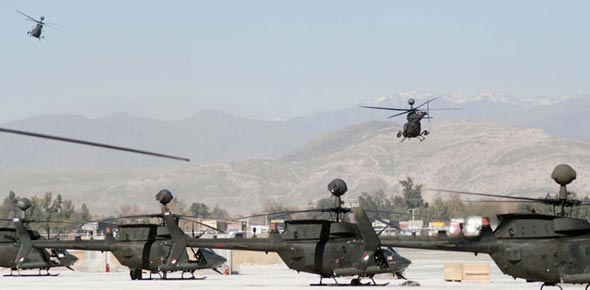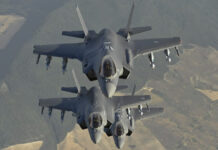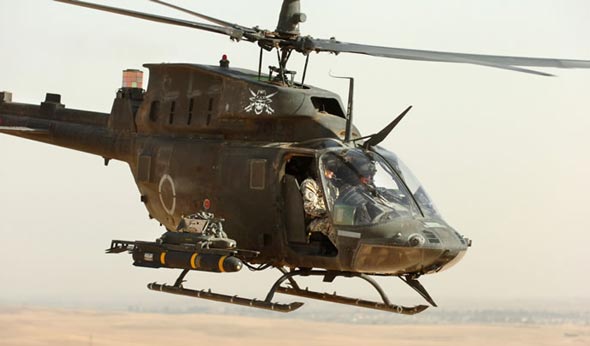
Kiowa Warrior is Back in the Fight
The U.S. Army fielded the OH-58D scout helicopter in 1983 and its ‘Kiowa Warrior’ armed reconnaissance derivative in 1991 as a single-engine, two-seat reconnaissance and direct-fire support helicopter. While this aircraft is considered obsolete by today’s terms, a replacement of the original model is not yet in sight and the Army plans to keep them as an integral piece of the Combat Aviation Brigade for years to come. To support the helicopters, a Sustainment Maintenance Program (SMP) and Survivability Enhancement Program (SEP) were required to improve flight safety and survivability, reduce platform sustainment costs and contain the expense of replacing aging helicopters. However, these upgrades will not solve the OH-58’s main deficienc – limited capability to operate in high altitude and hot climate, characteristic of the Afghan theater of operation. To improve performance in such conditions, re-engining the current platforms or fielding a new armed scout helicopter.


While the Army has yet to determine which armed scout it would like to field, the current armed reconnaissance helicopters known as Kiowa warrior (OH-58D) is going strong. Under the current modification program 371 helicopter are being modernized Safety Enhancement Program (SEP) configuration.
Under a follow-on program Bell will convert OH-58A helicopters into the OH-58D Kiowa Warrior, under the “A2D” program, recently awarded by the U.S. Army. This conversion intends to replace wartime losses and battle damage suffered by the OH-58D Kiowa Warrior. As part of the initial phase of the program Bell will convert eight cabins; the Army has an option to take ten additional converted Kiowas under this contact, to be followed by fulfilling additional conversions on demand, to replace wartime losses.
Bell is also working on an avionic modification designated Cockpit and Sensor Upgrade Program (CASUP), to be implemented with Kiowa warrior, under the new designation OH-58F. According to Colonel Robert Grigsby, Army’s Armed Scout Helicopter program manager, the low-risk upgrade is based on non-developmental items and systems fielded on other aviation. The primary change introduced with CASUP is the installation of nose mounted sensor, replacing the complex mast mounted system.
The cockpit instrumentation includes three full color multi-function displays and digital inter-cockpit communications. Dual-redundant digital engine controller will improve engine safety. The CASUP upgrade will also include redesigned wiring harnesses, setting the infrastructure for future upgrades of the weapon system and electronic countermeasures. The cockpit and avionics will fully integrate with the capabilities of Level 2 Manned Unmanned Teaming, already available in AH-64 Apache helicopters. Additionally, the F model will fully integrate the capabilities of Level 2 Manned Unmanned Teaming, Common Missile Warning System (CMWS), Health and Usage Monitoring (HUMS), and enhanced weapons functionality via 1760 digital interface.
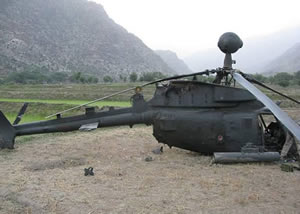
To improve the Kiowa Warrior’s performance in high-hot conditions, Bell is proposing to replace the current Rolls-Royce Model 250-CR30 engine with Honeywell’s HTS900-2 offering up to 50% power increase. This modification and other improvements could be part of the OH-58 Block II ‘fleet representative demonstrator’ Bell is developing to address U.S. Army future requirements.
A more radical modification of the Kiowa Warrior is proposed by AVX, a small aeronautical design company from Texas. As part of the proposed modification the tail rotor will be eliminated and the main rotor assembly will be replaced with coaxial rotor system. According to AVX, this radical change will dramatically improve the performance, flight safety and survivability of the helicopter. According to AVX the new compound helicopter could be 25% faster. The modification could also be cheaper than re-engining the helicopter, as Bell porposed.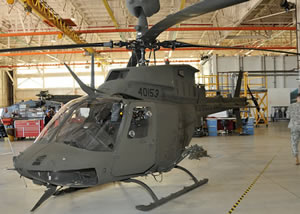
If the Army would consider a new platform, EADS North America and Lockheed Martin are likely to offer an armed version of the UH-72 Lakota utility helicopter. The team has already produced three AAS-72X demonstrators for this purpose. AgustaWestland is likely to offer a militarized variant of the AW119 while Boeing is likely to submit the AH-6 which recently won its first international orders in the Middle East. As such Request for Proposal is likely to materialize in 2014 or later, the S-97 Raider under development at Sikorsky could also be considered by the Army.
